PacketStream Review 2025
Rotating/static residential proxies powered up with multi-hop proxy tunnel, and content verification tools.
When analyzing the proxy, we have conducted in-depth research that helped us reveal all the strong and weak points of the service. Considering expert opinion and customer feedback, our pros studied the range of options and, finally, tested the service.
Here are the steps we followed when conducting research:
Analyzing the customer feedback
We have visited several forums devoted to proxy discussion and even participated in it. We have studied reviews on reliable resources with only one purpose – to make our review precise.
Getting to know the expert opinion
We have communicated with experts in the proxy industry. To uncover some hidden pitfalls, we asked professionals about its key features. In our review, we will tell you everything you need to know about the strong and weak points of the proxy provider.
Studying Terms & Conditions
At this point, experts have studied the legal basis. They have touched upon the place of registration, owners, achievement, reputation, and so on.
Exploring proxy types
To understand the quality of services the company provides, we test each of the proxy types it offers. The range of proxy types can vary as well as their quality.
Evaluating the quality of support
The support team reflects the reliability of the company hence it is essential to check it. We pay attention to response time, the communicative skills of managers, and the usability of the service. Besides, our expert becomes a real user to get into the situation of purchase.
Testing the service
We have checked the proxy provider’s backward and forwards. To make our research full and deep, we have tried out all proxy types offered there. Our experts have analyzed the work of servers paying attention to their features and functionality. In our review, you can look through a detailed description of features.
Comparing
Our experts have compared this proxy with other popular services. In their comparison, they have touched upon the pricing, set of features, and characteristics. You can find out more in the Comparison section of the website.
- QA testing & Price comparison
- Targeting by country, random, and city targeting coming soon
- Peer-To-Peer Bandwidth Sharing
- An option to sell your bandwidth
- Limited types of proxies
- Limited use cases
Characteristics
- IPv4
- English
- Germany
- France
- Italy
- Netherlands
- Spain
- Albania
- Andorra
- Angola
- US
- Brazil
- India
- Mexico
- Argrentina
- Turkey
- UK
- Canada
- Japan
- Belgium
- Czech Republic
- Lithuania
- Portugal
- Slovenia
- Ukraine
- Denmark
- Hungary
- Romania
- Greece
- South Korea
- Finland
- Switzerland
- Norway
- Poland
- Cyprus
- Singapore
- Indonesia
- Australia
- China
- Colombia
- Egypt
- Philippines
- Seychelles
- South Africa
- Taiwan
- Thailand
- Vietnam
- Ireland
- Israel
- New Zealand
- Residential Proxies
- HTTP
- HTTPS
- Direct
- Backconnect
- Rotating and static IPs
- Peer-To-Peer Bandwidth Sharing
- PacketStream's multi-hop proxy tunnel
- Content Verification tools
- API for resellers
Overview
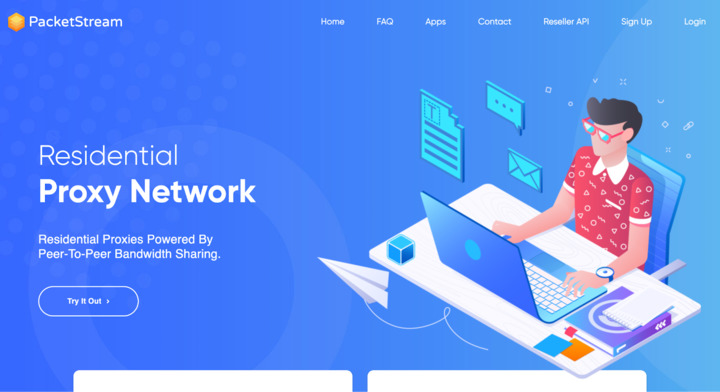
Established in 2018, this US proxy provider offers access to low-cost residential IP addresses for a vast range of users. It is also a marketplace where one can purchase proxies as well as sell their own traffic. PacketStream (PS) is the first-time service provider to be so sincere in its business model.
This explicit business model has made it possible to gain a solid number of residential IPs on short notice. However, even the lowest price ($1 per gigabyte) has not made PacketStream less dependent on its bandwidth sellers, who can always make or break the entire network.
Key Features
● Residential Proxies
● Peer-To-Peer Bandwidth Sharing
● Selling Your Bandwidth
● Targeting: Country, Random
● Referral Program
● IPv4 Protocol
● Getting Paid with PacketStream
● API for resellers
● Free Trial
● Safety Inspection
Best For: QA testing & Price comparison
Verdict
PacketStream is a peer-to-peer proxy network that reimburses its users for sharing bandwidth on its network. This is a legitimate platform that pays for bandwidth users share. However, what do the people from either side really get when choosing such a service? First and foremost, PacketStream provides access to web content that can otherwise be blocked or finalized if using a traditional proxy service. Packet Stream proxies can be considered a universal key to unlatching content confined to particular regions. Meanwhile, it is also an effortless opportunity for passive income.
Feature-Set and Guidance
This somewhat unusual proxy provider has already taken a decent space among all the other companies in the industry. Here is most probably not the most extended list of feature-set you have ever seen among proxy services, yet still, we underline the most remarkable highlights:
● Residential Proxies
● Peer-To-Peer Bandwidth Sharing
● Selling Your Bandwidth
● Targeting: Country, Random
● Referral Program
● IPv4 Protocol
● Getting Paid with PacketStream
● API for resellers
● Free Trial
● Safety Inspection
So, let’s dive a little bit deeper.
Residential Proxies
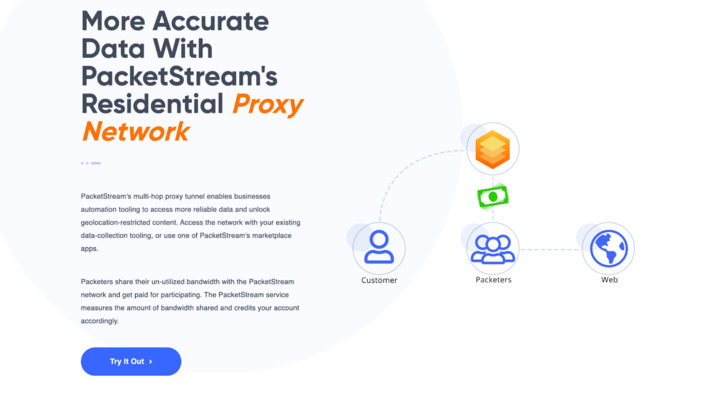
Packet Stream claims to have about 7 million residential proxies on offer, although we realize this number is fluid since it directly depends on participants of its bandwidth-selling program. As we have already stated, PacketStream residential proxy is not heavy on features, yet the most important is here.
The proxies spread among most countries in the world. In the dashboard, you can see the locations but not how many IP addresses each one of them has; hence you will need to believe and rely on the provider. A year or two ago, no other targeting options – like ASN – were available, but now you can target by cities or leave it for random. We also advise ruling out streaming sites and torrents in the first place, as SOCKS proxies are not supported at PacketStream.
The residential proxies in this company are peer-to-peer, meaning they inevitably rotate. You can select rotation for every request or hold the same IP address for as long as it is available.
There is no possibility to whitelist IPs, so you will have to go through ‘user-pass’ authentication. And even though PacketStream has API for resellers, sub-users are inaccessible.
Publicly the company announces that you can use the proxies in any way you might need, but in fact, its terms and conditions do prohibit some use cases, and most of all, it concerns advertisement spam.
Selling your bandwidth
When you first sign up at the PacketStream website, you will need to answer about your purpose for joining the platform. For example, if you want to earn some money, your membership status will be a Packeter. By selling their bandwidth, Packeters make it possible for users to browse the web privately and safely. To become a Packeter, you will need to install the software: the Packet Stream Client and the app. Once done, you just need to log in to your account and begin earning credits. The software will passively allocate bandwidth to users wishing to use PacketStream’s services.
Yes, it is that easy. All you need is to run the software in the background. However, keep in mind that your internet connection speed will decrease when the bandwidth is being shared. That is, in fact, the only drawback of acting as a Packeter. But if you decide not to agree to that arrangement, there is still a way to earn from this proxy provider. Furthermore, you can let the program run in the background only when you do not use your computer. Hence, no compulsion; feel free to adjust the software according to your own needs.
Referral Program
Another way to earn from PacketStream is by encouraging other people to acquire membership. You invite people via your unique invite link. As soon as they register through your link, they will become your referral.
This grants you a 20% commission for whatever your referral will earn from the platform. This commission will not be deducted from your referral’s income. Instead, it will be shouldered by PacketStream. So the more your referrals earn – the higher your own profit will be.
Getting Paid with PacketStream
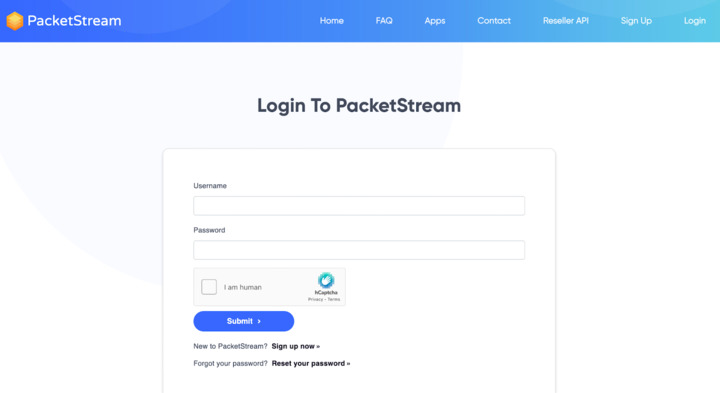
So, as we now know, PacketStream pays for the bandwidth its members share with its users. However, let’s be precise here: technically speaking, a member does not get paid for the bandwidth they share. Instead, they get paid for the amount of data provided by sharing the bandwidth.
Every member earns $0.10 per 1 gigabyte of data they share. You can request payment as soon as you make a minimum of $5; PayPal or Stripe are at your disposal.
Be ready for a 3% fee which is applied to cashouts. Such a low payout threshold is pretty easy to reach, and the payout requests might be fulfilled on a quicker and more frequent basis.
Two key factors influence the amount of income you can earn from PacketStream. The first is the relevant bandwidth of your internet connection. And the second one is how often you allow the software to share your bandwidth.
Obviously, you can sell more data quicker if you have a more rapid internet connection, meaning you can earn faster. Therefore, you will have a more significant earning potential in case of a fast internet connection.
If you use your computer regularly, letting the software run in the background can be destructive and unprofitable since it will slow down your connection. Hence, it is good to allow bandwidth sharing only when you are away from your computer. However, other people might ponder that, in such a case, they will have to let their computer run, which will eat up power, which could reflect in an electric bill. So, you decide if it is worth it, depending on how expensive electricity is where you live.
Letting PS run on several of your devices only makes sense if they have different IP addresses and do not use the same internet connection. If that is the case, then it is indeed a way to boost your earnings. Otherwise, it can take some time to make some profit on PS. Yet again, you do not have to do anything meanwhile and, thus, can earn passively.
Safety Inspection
PacketStream collects personal information for two purposes:
- Account creation (i.e., username, password, email)
- Payments (not always collected): phone number, address, PayPal account info.
The website also automatically collects cookies and device information (IP address, OS, and browser version).
However, PacketStream ensures they never use or share customers’ data for commercial purposes.
Remember that simply not giving your consent allows you to opt out.
This proxy provider claims that all information passes through its servers prior to being processed. They do so in order to prevent IPs from being used for illegal activities. Once detected, such accounts are automatically banned. However, although it sounds really great and reassuring, the service provider can hardly explain what constitutes an illegal activity from its point of view.
Overall, we have no doubts that PacketStream does its best to guarantee the security of its users. Nevertheless, the mere act of renting out your IP address might be risky. It will not get you into any legislative trouble, yet it could get your IP address restricted or banned from some websites.
Usability
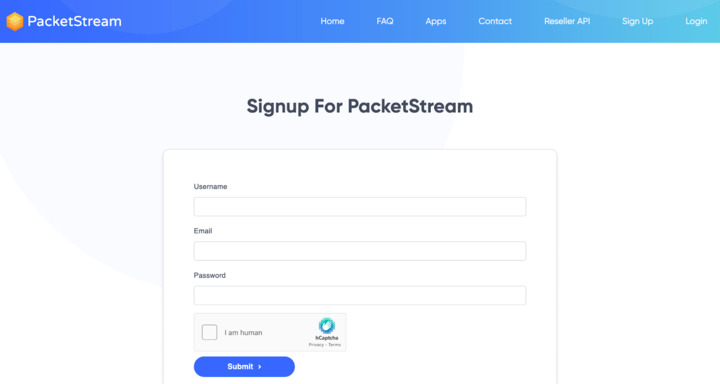
PacketStream has a relatively simple dashboard that is not overloaded with features and is meant to serve both sides of its business. One part is devoted to traffic sellers, and the other one is intended for proxy users. On the dashboard, you will be able to buy bandwidth and see your traffic stats and invoices. In addition, a button for reaching out to customer support will merely lead you to the FAQ page.
On the setting-up proxies page, you will find automatically generated cURL commands depending on your setup guides and choices, as well as code examples for programming admission.
And there is also a form to request access to the Reseller API.
All in all, except for missing prompt access to customer service, the dashboard provides everything a user might need. You will also need to use the dashboard to set up proxies on PacketStream to generate your cURL command or an IP-Port. Here, you will choose items from separate drop-down lists. A nice touch is the ability to change between the IP hostname and the DNS hostname at your own will.
Customer Service
At the moment of writing this PacketStream review, over 450 people left their feedback on the PS services on TrustPilot, and 75% of them rated their experience as Excellent. Unfortunately, even though the total score is 4.0, the company’s team does not seem to bother replying to negative feedback. Whereas positive PacketStream reviews look like this:
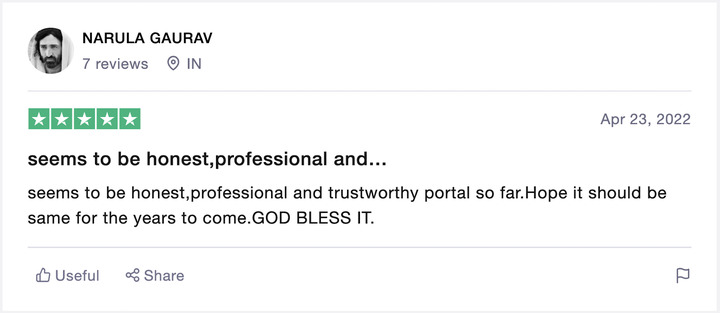
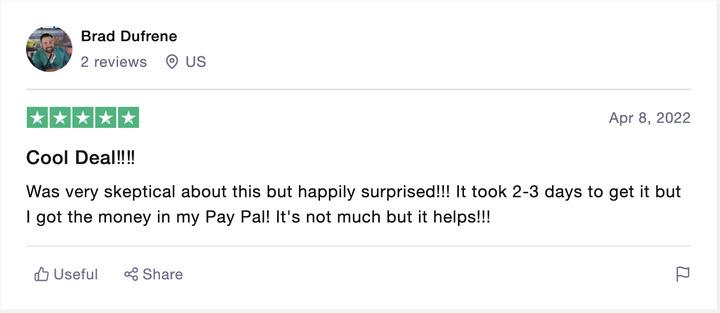

As for customer support, you can only reach them via email. While researching and preparing our PacketStream review, we contacted the provider several times and received a reply within 12 hours.
However, it turned out that not all users were that lucky: we found out that mainly tickets get replies within 24 hours. Packet Stream claims to provide 24/7 support, but in reality, things prove to be different. Let’s agree this is not the worse scenario, but it could be a stumbling block for enterprise clients.
Pricing
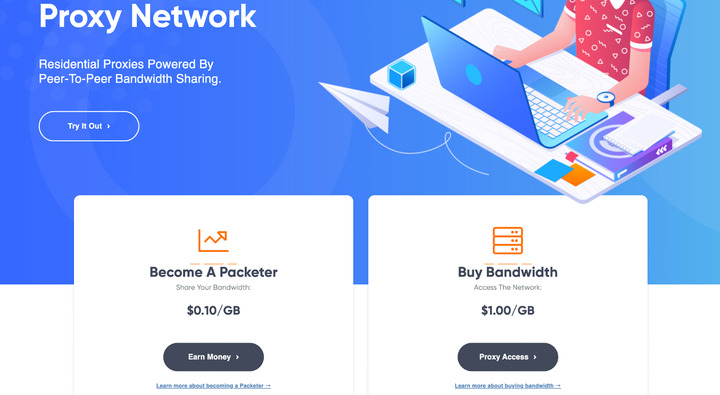
The price is probably the main reason why most people might wish to consider joining PacketStream. Many users may want to avoid setting up a complicated system of proxy tiers and packages and, instead, go for a very simple offer of $1 per GB of bandwidth. You purchase the bandwidth and get access to the whole network. You do not have to buy individual proxies. Given that these proxies are all rotating, if one IP address becomes inaccessible, you will always get another one ready to replace it.
The only warning to this pay-as-you-go system that we would like to share with you is the inability to actually buy $1 worth of bandwidth to probe things out before investing funds further. The minimum amount of bandwidth for purchase is 50GB, whereas some other companies let it start off for less than $50. Buying 100, 500, or 1000 GB right off the bat is also possible in case you wish to go all out instead. Whatever it was, PacketStream’s price per GB of bandwidth is one of the cheapest and most affordable out there. Besides, you can also avail a free trial to test the service for a few days.
Performance Testing
During our testing period, Packet Stream had a few unique IPs, and every fourth connection request led to a new proxy.
Country gateways’ testing results were likewise underwhelming. PacketStream was able to muster about 5,000 IPs in the majority of European locations, and, in Australia, it was fewer than 500. Its American pool was significantly more extensive, but what surprised us the most was probably its most considerable presence in Russia.
On the bright side, Packet Stream proxies went from residential devices. The residential proxies had a relatively high success rate – check out our chart below. Besides, we were sure that, as an American provider, these proxies would be the fastest, but it appeared to be the slowest location.
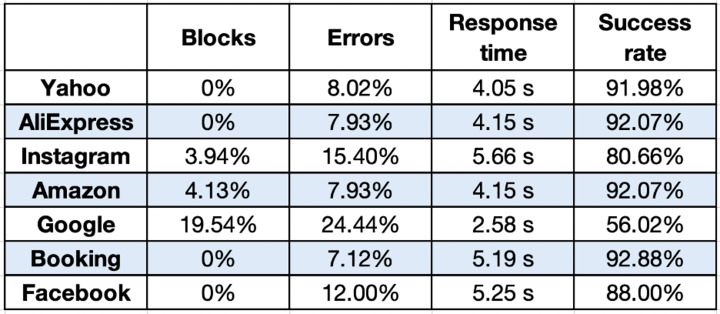
Provided that PacketStream is a cheap service provider with a bounded proxy pool, we can say that the overall performance testing went well. Their response rate was fewer than five seconds, and it has managed to complete the 85% of requests. Therefore, our guess is that the reason for some setbacks and failures was the overused IPs, especially in major targets like Instagram and Google.
If your proxy needs are unpretentious – by all means, feel free to go ahead and choose PacketStream, which is one of the best entry providers to test residential proxies. If you’re a business, we advise taking this provider into account as well. This is an attractive proposition, although we have some doubts regarding its non-technical facets like documentation or customer support experience.
However, you probably should hold off on PS if you’re an enterprise. Despite its strong fundamentals, the company still does not look ready for such a large-scale entrepreneurship space. All things considered, we like the business model and advise PacketStream to our readers.
FAQ
Residential use cases contain:
Web scraping
Private browsing
Ad verification
Prevention of an IP ban
QA testing
Geolocation control
Brand protection
Price comparison
The company employs different measures to support the safety and privacy of all its customers. To keep all users’ data secure and safe, Packet Stream product engineers avail security practices and industry-established encryption.
To define whether the request is from a data center or residential IP, as well as a user’s geolocation, many websites avail IP lookup databases. If they detect that traffic is from a restricted country or appears from a non-residential IP, they often limit or block content. PS lets users relay their web requests via residential IPs to avoid these restrictions.
Any legitimate and legal use of PacketStream proxy services that do not violate any laws is allowed. However, particular automated use cases, like web scraping, might conflict with the Terms of Service of the requested website. Hence, users should ensure their actions do not violate the ToS of the website they are using.
The following types of IP addresses are available and allowed for usage: Residential, Café, Mobile, Portable Hotspot, and School.
Additionally, the company states that, in the future, it will also support business, data center or hosting, and library IPs.
The target website can only see the IP of the Packeter, which is relaying the request. The PS tunnel does not envisage any HTTP request headers that could reveal a user’s IP address. Instead, the request appears like an ordinary HTTP request without any proxy identifiers.
The ‘Randomize IP’ feature at Packet Stream rotates residential IP addresses after every executed request to the proxy. A new IP is issued randomly for every request. This solution works best for most use cases.
Whereas a ‘Sticky IP’ feature assigns a single static residential IP that is available for re-usage for numerous connections during a session. Sticky IPs remain static and operate until the session is disabled. This solution works best if you require a non-changing residential IP for different requests.











